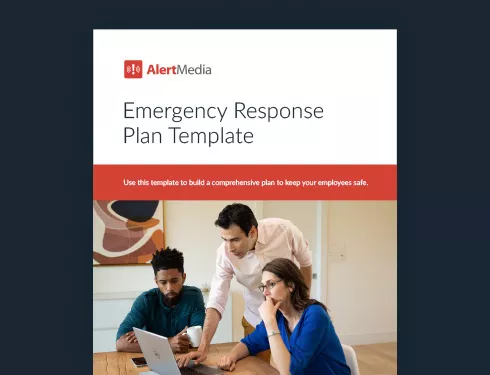Your best defense in a crisis is a well-prepared team. Follow these key strategies to create an emergency operations plan that adapts to any situation.

Develop an Emergency Operations Plan to Guard Against All Hazards

Imagine if a wildfire, hurricane, or earthquake struck your company’s headquarters. Are you confident that everyone in your organization would know how to respond?
When you imagine those three disasters, you might picture different details. But for a safety leader, the core premise is the same: keeping your employees safe and maintaining business continuity. You can’t always predict the incidents your organization will face. However, you can develop procedures to protect your team in any evolving situation. Enter the emergency operations plan (EOP).
Jeff Dow, a protection and resiliency manager at a national financial institution, said, “You have to spend enough time left of boom so when you get right of boom, it’s a little bit easier to get back to normal.” In other words, the more you plan and prepare before a disruptive event—the “boom”—the smoother your recovery will be. That’s the role of an emergency operations plan: giving your emergency response team a well-rehearsed playbook to follow when the unexpected happens.
Read on for practical guidance on building your plan, including lessons from Dow’s experience leading resiliency efforts in both the public and private sectors.
Download Our Emergency Response Plan Template
The Foundation of Emergency Management Planning: Your EOP
Emergency operations plans outline what organizations should do during disasters. An EOP includes organization-wide directives like incident command at your emergency operations center (EOC) and communication protocols. EOPs also cover department-specific plans such as evacuations, equipment management, and critical operations maintenance.
Your EOP should take an all-hazards approach, meaning your team can use it for any type of emergency. However, it should include annexes for specific scenarios your company will likely face. Jeff Dow emphasized that planning can’t rely on static checklists or assumptions. It has to account for shifting threats and limited resources. His team supports thousands of employees across nearly every U.S. state, forcing them to build flexible systems that can adapt to everything from wildfires to cyber incidents. The same principle applies to any EOP: It should be structured enough to provide clarity and adaptable enough to guide action regardless of the hazard.
Listen to Dow’s full interview in The Employee Safety Podcast to learn how a lean team can support enterprise-wide resiliency across all hazards.
What happens inside an emergency operations center?
Since the emergency operations center (EOC) plays such a central role in emergency management planning, it’s essential to understand how this coordination hub functions during an actual disaster response.
The EOC is where organizational response efforts come together. It may be a dedicated physical space or a virtual environment, but its function is the same: to coordinate emergency actions, manage communications, and maintain situational awareness across departments. Teams from HR, IT, public health, safety, and executive leadership work side by side to oversee emergency support functions and issue emergency alerts. These teams ensure that internal updates and public notifications are timely and accurate.
The EOC also handles external coordination with fire departments, emergency medical services, public works, local and state agencies, and federal agencies. According to Jeff Dow, regular collaboration between the executive steering committee and the crisis response leadership team made activating and operating the EOC during real events easier. “When we do have to meet with them during a crisis,” he explained, “it’s not the second time I’ve talked to an SVP.” That familiarity strengthens your organizational structure and ensures that response teams can act decisively when every minute counts.
A well-managed EOC links your internal teams to the broader emergency management system, which includes government, private sector, and community stakeholders.
Align your EOP with regulatory requirements across industries
A strong EOP isn’t complete without compliance. In addition to outlining tactical disaster response and incident command system procedures, your plan must align with legal, regulatory, and industry-specific standards. Compliance ensures your planning process can withstand review from auditors, insurers, and federal and state agencies.
Your EOP should also support broader national preparedness goals. That includes demonstrating coordination with public health authorities, homeland security programs, and local government agencies.
This broad alignment is especially critical in regulated industries such as:
- Finance, where organizations must maintain customer access to funds during emergencies
- Healthcare, which must meet strict Centers for Medicare & Medicaid Services (CMS) Emergency Preparedness Rule requirements and plan for mass care, patient safety, and mental health needs
- Energy and utilities, where outages and environmental hazards trigger oversight from federal government regulators and require detailed hazard mitigation strategies
- Manufacturing and chemicals, where EOPs must address spill response, fatalities, and coordination with firefighting and public works departments
- Education, which often requires integration with local governments, school safety mandates, and emergency notification and dissemination procedures
To meet those standards, your EOP should reflect established guidance from widely recognized regulatory frameworks. Some to consider include:
- OSHA 1910.38: Emergency Action Plans
- FEMA’s Comprehensive Preparedness Guide 101
- NFPA 1600: Standard on Continuity, Emergency, and Crisis Management
- CMS Emergency Preparedness Rule (for healthcare organizations)
- National Incident Management System (NIMS)
- State government mandates and executive orders
Failing to comply with these guidelines can result in regulatory penalties, legal liability, or reputational damage, especially if your organization is unprepared after a fatality or natural disaster. A compliance risk assessment can help reduce that risk by systematically reviewing your emergency operations plan against applicable regulations, identifying gaps, and recommending updates to strengthen alignment with legal and industry standards.
The emergency management lifecycle
Your company faces an array of operational risks that could lead to an emergency. The specific response to each may be different—for example, a fire extinguisher won’t do much good for an infectious disease spread. But, despite these diverse scenarios, every emergency’s lifecycle falls into five phases:
- Prevention: The first step is to take reasonable steps to avoid an emergency. For example, using fire-resistant materials in building construction helps prevent the risk of deadly fires.
- Mitigation: Next, have a mitigation plan to reduce the impact of emergency situations you can’t avoid. If you’re in a tornado-prone area, you can’t prevent them, but you can build a storm cellar as part of a tornado preparedness plan to stay safe when they strike.
- Preparedness: The preparedness phase focuses on gathering the necessary resources to survive a disaster, such as an emergency supply of food and water for an earthquake, hurricane, or other incident.
- Response: The response phase involves implementing plans once an emergency occurs. Those plans could include evacuating, sheltering in place, shutting down heavy machinery, or containing hazardous materials.
- Recovery: Once the immediate threat has passed, your goal is to recover normal operations. Common recovery activities include restarting equipment and inspecting facilities, while extreme recovery measures may consist of reconstructing buildings or setting up alternate locations to resume business.
EOPs focus on the response effort but don’t exist in a vacuum. Hazard mitigation and preparation will guide the assumptions included in your EOPs. And your recovery goals will dictate the potential outcomes you plan for within your larger emergency management program.
Integration with business continuity and disaster recovery plans
Because recovery is rarely clean or immediate, your EOP must integrate seamlessly with your disaster recovery and business contingency plans. The EOP governs life safety, situational coordination, and the initial response, while the business continuity plan (BCP) focuses on sustaining essential operations, and the disaster recovery plan (DRP) guides the restoration of systems, data, and infrastructure.
Jeff Dow shared a powerful example of this integration in action. When a polar vortex brought extreme weather to the Midwest in 2019, his organization made the rare decision to close multiple buildings and shift to remote work for a day. While initially a short-term emergency response, it required rapid coordination across safety, operations, and IT to maintain essential services, effectively putting their continuity planning into motion. That experience exposed gaps, clarified roles, and strengthened their ability to respond to COVID-19 a year later.
Key Components of an Effective EOP
While EOPs all address the same overarching need, they vary widely in scope. Every organization will focus on protecting lives above all else, but that can take various forms. For example, a chain of department stores can focus on evacuating employees and customers in an emergency. In contrast, a hospital will need an EOP that allows personnel to continue caring for patients throughout a disaster.
Despite these variances, all EOPs will contain certain key components:
- Risk assessment: A robust EOP will take an all-hazards approach, providing for any emergency you might face. However, focusing on the most realistic and dangerous risks allows you to develop plans suited to your organization’s threat landscape.
- Roles and responsibilities: Your emergency action plan must detail who is responsible for each section. It’s also essential to include backups for key roles in case some people are unavailable or unable to carry out their emergency support functions.
- Communication protocols: Disasters often create confusion, so your EOP needs clear procedures to keep everyone informed. Internally, your plan should identify how departments will coordinate, who is responsible for sending updates, and what to do if primary systems fail. Externally, it should outline how your organization will communicate with vendors, customers, and public safety officials. That might mean assigning a spokesperson, translating key messages, or using pre-approved templates to speed up response times. However it’s handled, the goal is to ensure the right people get accurate information at the right time, no matter the circumstances.
- Response activities: The response section will constitute the core of your company’s emergency response plan. It should focus on a general approach to emergencies, leaving specifics to appropriate annexes and related planning documents.
- Operational continuity plans: To whatever degree is safe, you’ll want to develop plans to keep business operations running. The cost of downtime can be substantial, affecting revenue, compliance obligations, and customer trust. Your plan should also consider how the emergency will impact external parties such as vendors, clients, and partners.
- Training and exercises: Practice makes perfect, especially regarding emergency preparedness. Provide regular training on your EOP and run tabletop exercises or emergency drills on procedures such as evacuation. Use a combination of methods—such as in-person sessions, online modules, and scenario-based simulations—to reach different learning styles. Conduct organization-wide drills annually and refresh role-specific knowledge at least quarterly.
Download the Emergency Response Plan Template
Plan activation and deactivation criteria
An EOP isn’t helpful unless your team knows exactly when and how to implement it. Activation criteria provide clarity during chaotic moments and help enforce a consistent chain of command. Your EOP should define specific scenarios that warrant activation—such as severe weather, infrastructure failures, cyber incidents, or hazardous material spills—and establish who has the authority to initiate or deactivate the plan.
Activation Criteria | Deactivation Criteria |
| State or local emergency alert, disaster declaration, or executive order issued by the governor or mayor | All-clear issued by state or local emergency management agency or governor’s office |
| Immediate threat to life, property, or operations (e.g., active shooter, explosion) identified by the Security Director or Safety Officer | Situation stabilized and confirmed by Incident Commander or Public Safety Lead |
| Severe weather event projected to impact operations, assessed by the Emergency Manager or Facilities Director | Threat has passed and operations cleared for re-entry by the Facilities Director or Operations Chief |
| Confirmed hazardous material spill or environmental threat reported by the Environmental Health and Safety Officer (EHS) | Site declared safe by EHS Officer or external environmental authority |
| Major IT or utility outage disrupting essential functions, confirmed by the IT Director or Infrastructure Lead | Systems restored and validated by the Disaster Recovery Coordinator or IT Director |
| Direction from federal agency or state agency (e.g., FEMA, DHS, OSHA) received by the Emergency Management Liaison | Regulatory response complete and transition authorized by Compliance Officer or Agency Liaison |
| Mass casualty or fatality event reported by On-Scene Commander or Medical Director | Life safety response complete and recovery phase approved by Incident Commander |
| Request for mutual aid or inter-agency support approved by the Emergency Coordinator or Agency Liaison | Mutual aid assistance demobilized with sign-off from the Emergency Coordinator |
| Activation of emergency support functions (ESFs) across departments initiated by the EOC Director | ESFs deactivated with confirmation from the EOC Director or Planning Section Chief |
| Critical staffing shortage or disruption confirmed by the HR Director or Continuity Manager | Staffing levels restored and approved by the HR Director or Operations Lead |
| Activation determination made by Incident Commander, CEO, or Crisis Management Lead based on threat assessment | Deactivation authorized by Incident Commander, CEO, or designated Recovery Lead |
Activation should trigger immediate notification procedures to alert the designated response team, initiate relevant emergency support functions, and open your EOC. Likewise, the plan should outline how and when to deactivate the response phase, begin formal recovery efforts, and communicate the transition through an all-clear message or status update.
Resource management and logistics
Even the best-written emergency plan will fall short without the right resources. Your team needs a strategy for identifying, sourcing, and distributing supplies, personnel, and equipment before, during, and after an emergency.
This strategy includes assigning roles for managing inventory and coordinating resource deployment across departments. Organizations should maintain up-to-date lists of essential assets, identify alternate suppliers, and establish mutual aid agreements that allow them to draw support from external partners. Supply chain disruption should be part of the equation. You’ll need a reliable backup plan if your go-to vendors can’t deliver.
Effective logistics ensures your people aren’t left waiting for critical supplies when it matters most. Whether it’s protective equipment, fuel, or communications gear, knowing what you have and where to get more of it is just as important as knowing what to do.
Best Practices for Developing and Maintaining Your EOP
Emergency operations plans are living documents that need ongoing changes and improvement. Here are eight ways to create the ideal EOP for your company.
1. Build preparedness into your organization’s culture
A robust safety culture goes hand-in-hand with operational resilience. By always putting safety first, you instill confidence that you’ll never put employees at undue risk. And in turn, they’ll look out for each other, constantly reinforcing the idea of mutual protection.
In a well-prepared organization, safety becomes instinctive. Employees understand the procedures outlined in the emergency operations plan, know who to report to during an incident, and can act quickly without waiting for clarification. Your team won’t waste time figuring out where to go or what to do when a real event happens—whether it’s a chemical spill, severe weather, or a facility lockdown. They’ll know how to initiate emergency support functions, follow instructions from the incident command system, and work within the structure of your response team.
This culture also extends into the recovery phase. Employees won’t expect to return to normal operations until it’s safe to do so, and your plan should make that clear. That matters especially in situations involving functional needs, disabilities, or high-risk environments, where premature re-entry can put people at risk.
Preparedness is also about communication. If someone has questions about the basic plan or procedures, they need a clear path to get answers. Give employees opportunities to ask questions, raise concerns, and provide input during updates or revisions. Making your plan part of everyday operations—not just something filed away for emergencies—builds clarity, confidence, and resilience.
2. Make your EOP accessible
Accessibility should be built into your planning process, not treated as a final step. And accessibility includes how the plan is distributed and how it’s written and formatted.
To improve accessibility across your organization:
- Include the basic plan in your employee handbook and onboarding materials
- Post clear links to the plan on your company intranet and in routine safety notifications
- Use plain language and avoid technical terminology or unexplained acronyms
- Translate the plan into other languages spoken by your workforce
- Ensure digital versions are compatible with screen readers and accessible to employees with disabilities or functional needs
- Add video, audio, or visual formats for key sections to support diverse learning styles
- Create a straightforward process for employees to ask questions or provide feedback on the plan
Accessibility is an ongoing responsibility you need to revisit during each plan update or after-action review. By making your EOP easy to access and understand, you increase the likelihood that employees will engage with it, follow it correctly, and help ensure a safer, more coordinated response.
3. Account for vulnerable populations
When planning for emergencies, it’s essential to include the needs of individuals who may face barriers to safety or communication. These individuals may include employees or visitors with disabilities, limited English proficiency, or medical conditions that require additional support.
Your EOP should outline how to accommodate these groups during all phases of an emergency. This might involve assigning aides to assist with evacuation, ensuring accessible routes are always available, or offering emergency communications in multiple languages and formats. Inclusivity is a legal and ethical requirement. Planning for everyone ensures no one is left behind when it matters most.
4. Audit your plans regularly
As your organizational structure, personnel, or physical footprint changes, your plans must evolve in parallel. That’s especially true after major disruptions—a new office building, updated safety regulations, or a shift to hybrid work. The best way to stay prepared is to treat your EOP as a living document and revisit it after every emergency or operational change.
That’s exactly what Jeff Dow’s team did following the polar vortex event discussed earlier. The disruption pushed them to reevaluate outdated assumptions, especially as their workforce became more decentralized and fewer people were on site. That reassessment led to key updates: clarified roles, more streamlined activation criteria, and long-term structural changes. As a result, when the pandemic hit, they could respond quickly and effectively, having already adapted their emergency procedures to account for a distributed workforce.
Revising your EOP is about building organizational agility. When the next disruption hits, you’ll have more than just a plan on paper. You’ll have a tested, adaptive framework that reflects your real-world conditions.
5. Incorporate lessons from real-life emergencies
The saying “safety regulations are written in blood” might not be true in a literal sense, but it’s not far off the mark. Some of the most important revelations about emergency response come from experience and seeing how plans go astray.
You may develop an EOP to be as comprehensive as possible, but real life doesn’t always conform to expected scenarios. Once imminent danger has passed, it’s important to document what went wrong and how you can improve. Use after-action reports, employee feedback, and leadership reviews to identify weak points and prioritize meaningful revisions.
In reflecting on the polar vortex aftermath, Dow shared that the experience exposed several operational gaps and made it clear the organization needed to adapt faster. “We became much more agile,” he said. In that moment, his crisis team didn’t wait for executive direction. They initiated remote work proactively and adapted on the fly. It was a turning point that reshaped their planning mindset: teams couldn’t afford to rely on top-down decisions or rigid protocols. They had to be ready to act quickly, adjust strategies in real time, and make decisions with the information available.
That event changed how they approached the planning process itself. It led to faster response structures, clearer decision-making authority, and a stronger foundation for future emergencies. Each incident is a chance to improve. The goal is to reduce the number of lessons learned the hard way and increase the ones you’re prepared for.
6. Collaborate with law enforcement and first responders
In a local emergency, you’ll probably need help from law enforcement or first responders, such as the fire department, search and rescue, police department, state agencies, and emergency medical services. Developing relationships with these groups early can help them understand your company and how they can assist in an emergency. Familiarizing them with your EOP allows them to provide input and enables you to refine internal procedures.
Collaboration can span several jurisdictions for larger companies or those in public safety sectors like energy or healthcare. Along with local connections, you might develop relationships with your state government, the Department of Homeland Security (DHS), the Federal Emergency Management Agency (FEMA), and other federal government groups.
7. Integrate technology for enhanced incident management
In an emergency, every second and every decision counts. Empowering your EOC with technology can give you a critical advantage in collecting, processing, and sharing information:
- Access to human-verified threat intelligence gives you actionable insight to make important choices without sifting through a mountain of public information
- An emergency communication system keeps you in contact with your team, ensuring they have up-to-the-minute instructions to stay safe
- An employee safety monitoring platform helps you keep tabs on at-risk employees and direct help where it’s needed most
- A travel risk management system enables you to communicate with employees who are traveling for work and monitor threats in their area
8. Keep records that support compliance and recovery
Every emergency response depends on clear, consistent documentation. Without it, there’s no reliable way to track decisions, communicate lessons learned, or demonstrate compliance. Your emergency operations plan should define the process for documenting events from start to finish, including how records are created, stored, and used. Adequate documentation begins the moment an emergency is recognized and continues through recovery.
Assigning responsibility is a key first step. Select people in advance who are trained to capture information in real time. Individuals might include those tasked with logging decisions, tracking how resources are used, and noting when communication goes out. Clearly define their roles within the plan’s structure to avoid ambiguity during emergencies.
The information collected needs to be accurate and secure. Plans should explain how to organize and protect records to support legal reviews, internal evaluations, or claims filed with insurance providers. Failing to maintain proper documentation could raise issues with auditors or government agencies, even if the response itself was handled well.
After the incident, leadership and frontline teams should review the documentation to identify gaps, clarify unclear actions, and support improvements in future planning. Lessons from real data carry more weight and lead to more informed changes. By treating documentation as a central function, not an afterthought, you give your organization a way to reflect, justify key decisions, and refine your emergency planning process over time.
Ensuring the Best Outcomes by Preparing for the Worst
When disaster strikes, it’s rare that everything will go according to plan. Shifting circumstances, unexpected disruptions, and new hazards will force your team to adapt quickly.
You won’t be able to control every variable, but you can control how well you’ve prepared. Throughout this article, examples from protection and resiliency manager Jeff Dow illustrate the importance of learning from real incidents, adapting quickly, and aligning leadership and operations through a well-structured emergency operations plan. That kind of preparation doesn’t eliminate risk, but it gives your organization the ability to respond with clarity, flexibility, and purpose.
A strong emergency operations plan equips your team with the tools to act decisively, protect one another, and sustain or restore operations under pressure. Even if things don’t unfold exactly as planned, you’ll know your organization was ready—and committed—to doing everything it could.


![11 Steps to Creating an Effective Emergency Response Plan [+ Template]](https://www.alertmedia.com/wp-content/uploads/2023/10/Blog-Emergency-Response-Plan.webp)

